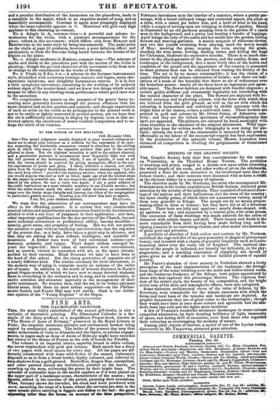MUSIC.
Six Duets for the Pianoforte and Violin, by Lours Srona. Op. 127. THESE Duets consist of six movements of varied and characteristi styles, called in the German journals—to account for the irregular fora, of composition, and assimilate them with certain popular productions of the like nature by MENDELSSOHN—Lieder ohne Mirk, or " Songs with- out Words." The principal effect here, as may naturally be antici- pated in the work of a great composer for and master of the violin, lies in that instrument ; while the pianoforte, though not reduced to mere accompaniment, is generally subordinate, and requires far less com- mand of mechanism and difficulty than the later books of MENDEL8- somes work. Good players are, however, required for both parts; and it will add much to the probable success of the violin-performer in the vocal strains before us if he have exercised himself somewhat in SPoint's Concertos, Quartets, and Quintets, and acquired the secret—half mechanism, half feeling and refinement—in which the true delivery of SPOHR'S elegant cantilena consists. An habitual concerto-player like SPOHR cannot write easy things, any more than he can pursue difficul- ties for the mere gratification of the vanity of execution : be must follow the bent of his fancy, under one restriction only, which he has always observed—fidelity to a high ideal of his art. He always ad- dresses himself to a refined and elegant audience, and puts his name to nothing which he would deem unworthy to be produced by himself be- fore the select circle of his own friends. The novelties and popular excursions of the master do not in any way compromise him as a mu- sician ; and the pieces before us, though in style and character essen- tially chamber-music, strictly speaking demand the abilities of concerto- players and a finished acquaintance with style and expression— the pianoforte in an inferior degree, the violin in the highest. No. 1. In E flat, 3 4.—The paternal features are strongly and very pleasingly imprinted on this the first of the family ; which is an allegro with a broken agitato accompaniment contra tempo, in the style of a fragmentary dramatic scene. The subject is alternately sweet and impassioned. A solo "sopra la quarts" of the violin, mingled with the high notes of the pianoforte, and afterwards with some runs of double notes on the same instrument, is uncommonly effective and new. Ju- diciously played, it makes a powerful appeal by the combination of tone and expression. No. 2. Larghetto in G, 6-8.—The combinations of this movement are varied, rich, and beautiful. A quartet of parts on the piano is ac- companied by the double notes of the violin, in a manner which, when the difficulties of double-stops are thoroughly mastered, produces en- chanting harmony. Two performers are surprised to find themselves playing a quintet or sestet. The design of the movement is also very novel and pleasing ; and it derives very considerable interest from a re- petition of passages of melody in contrasted keys, and with graceful pa- geolet or harmonic effects. The last note of the violin part which Ckiff11 on the fourth of the key is a formidable engraver's error. No. 9. In E minor, 3.4.—A religious introduction and reminisce:see of " The Last Judgment," with a canto ferino on the violin in octaves
and a peculiar distribution of the harmonies on the pianoforte, leads to a cantabile in the major, which is an exquisite morsel of song, and as beautifully accompanied. Contrast is again most pleasingly displayed when the same cantabile appears in C. Musicians will give very high applause to this charming movement,
No. 4. Adagio in A, common time.-A powerful and solemn in- troduction for the violin, with a pizzicato accompaniment for the piano, ushers in this movement ; which differs only from MOZART and ■ EKETHOVEN in the same style by being less sustained. The pedal point on the violin at page 25 produces, however, a most delicious effect, and particularly so from the fine tone being heard between the breaks of the triplets on the piano. No. 5. Allegro moderato in B minor, common time.-The mixture of sixths and thirds in the pianoforte part with the motion of the violin is pleasing; though the general character of the movement is far from new or strange to the connoisseur in the works of SPORE.
No. 6. Finale in E flat, 3.4.-A scherzo in the German instrumental style, diversified with numerous bowings staccato and legato, many cha- racteristic imitations, and delightful harmonious returns. It is in fact a little symphony-movement, containing in the working of its subjects evident signs of the master-hand ; and we know few things which would surpass its effect in any drawing-room performance where good taste was in the ascendant.
We congratulate the master on the prospect of his genial fancy be- coming more generally known through the present effusions than his more classical and severe quartets and quintets ; and though expectation of such an artist on the violin as he presupposes in the present work is not to be easily or lightly answered in general society, yet we hope that the art is sufficiently advancing to display by degrees, even in that un- wonted sphere, the excellence of sound classical composition and to en- large the circle of its votaries.



























 Previous page
Previous page